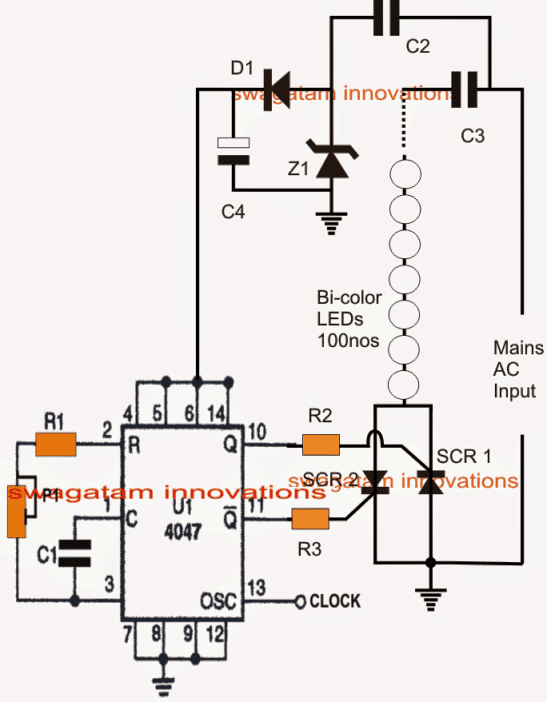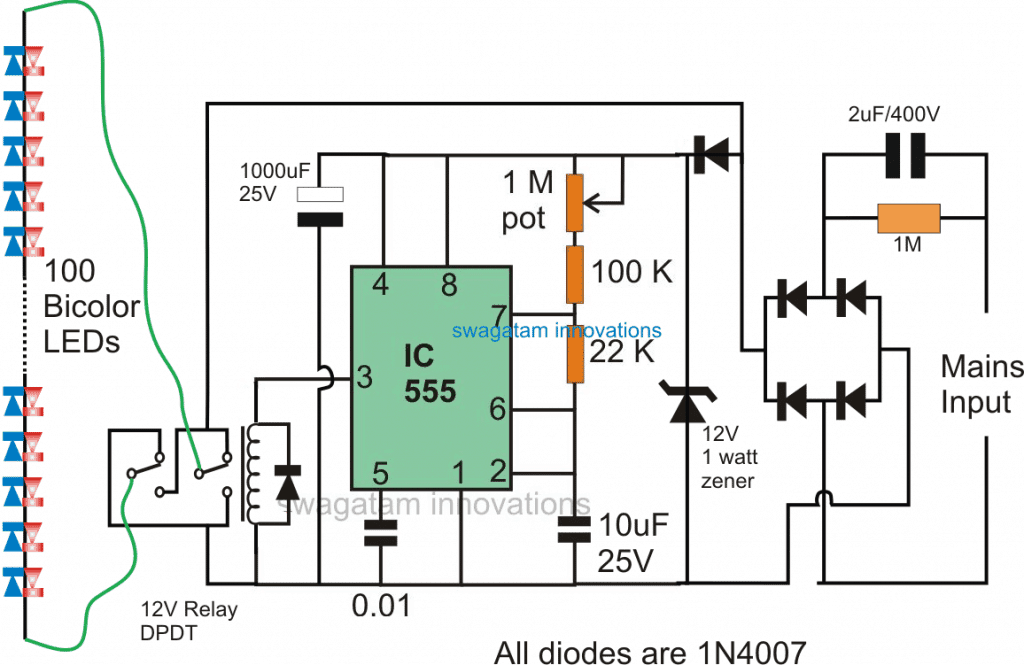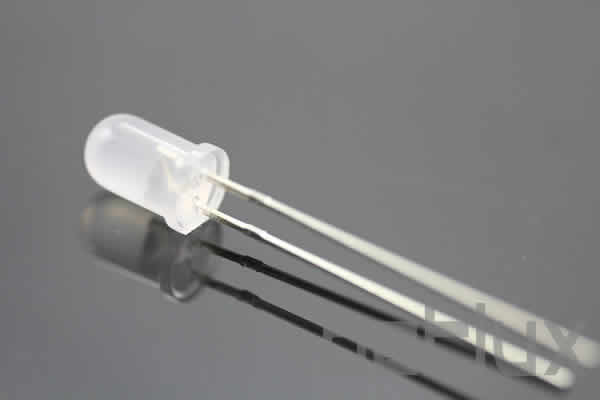This transformerless mains power supply circuit will allow flashing of a Bi-color 100 LED string, in an alternately switching red, green effect.
Using 2-pin Bi-color LEDs
The proposed circuit can be used as a Bi-color LED flasher, for generating an alternate red, green flashing effect over a string of 100 LEDs.

Bi-color LEDs are available in 3-pin and 2-pin variations, in our project we use the 2-pin Bi-color LED option for keeping things compact and much efficient.

Circuit Operation
Looking at the design shown above, we can see a simple configuration using a push-pull clock generator IC 4047.
The IC is used for generating an alternately switching pair of outputs, from the shown pinout#10 and 11 of the IC.
The frequency of these alternately conducting outputs can be set by appropriately adjusting the pot P1 and by selecting the desired range with C1.
The switching outputs can be seen configured with two oppositely wired SCRs, which are in turn hooked up with the Bi-color LED string across the mains input through a dropping high voltage capacitor C3.
The circuit also incorporates a transformerless power supply stage consisting of C2, D1, C4, Z1, for powering the IC with the required low voltage DC.
When the proposed 2 pin Bi-color LED flasher circuit is switched ON, the IC starts oscillating at the set rate across its pin#10 and pin#11 alternately, driving the SCRs at the same alternating rate.
The SCRs respond to these pulses and conduct accordingly, enabling the Bi-color LED string to illuminate through an alternately green and red color flashing effect.
Caution: The above circuit is not isolated from mains, therefore is extremely dangerous to touch in an uncovered and switch-ON positioned.
Parts list
- R1, R2, R3 = 1K
- C1, C4 = 100uF 25V
- C2, C3 = 0.33uF/400V
- Z1 = 12V 1 watt zener
- D1 = 1N4007 diode
- SCRs = 2nos BT169G
- LEDs = 100nos (for 220V input), 50nos (for 110V input) of 2pin, Hi-bright RED, Green Bi-color LEDs
- Input: 220V/110V
Correction Update
The design shown above has a serious flaw in it. The SCR1 is configured wrongly and might not conduct as proposed in the explanation.
The following diagram using an DPDT relay appears to be the correct approach for implementing the above discussed Bi-color LED flashing operations:

Two Color LED Blinker Using Neon Lamps
As seen in the following image, our next light string cycles between red and green at a consistent 1 Hz frequency, allowing it to be a lovely complement to any seasonal decoration. The process for changing colours happens as I have explained below.

A relaxation oscillator circuit made a couple of two neon lamps, NE1 and NE2, alternates back and forth at a rate of roughly 1 Hz.
The two color LED changeover rate is determined by R1, R2, and C3 numbers. C2 and D1 provide DC power to the neon oscillator circuit. DC filter capacitors are not employed or required.
When NE1 activates, current passes via an optocoupler in U1's LED, switching on the SCR and grounding D2's anode in the process.
Due to this , the LEDs get just the positive half of the AC waveform, which only illuminates the red LEDs (LEDs 1 through 30). After around one second, NE1 switches off, NE2 switches on, and U2 grounds the cathode of D3 as a result.
As a result, the LEDs get only the negative half of the AC cycle, which only illuminates the green LEDs. You may decrease the values of R1 and R2, and increase the value of capacitor C3 to decrease the frequency, in case you want to reduce the red/green alternating rate to less than one second.
